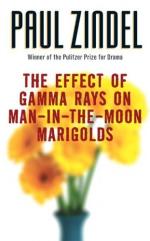|
This section contains 256 words (approx. 1 page at 400 words per page) |

|
The Effects of Gamma Rays on Man-in-the-Moon Marigolds Summary & Study Guide Description
The Effects of Gamma Rays on Man-in-the-Moon Marigolds Summary & Study Guide includes comprehensive information and analysis to help you understand the book. This study guide contains the following sections:
This detailed literature summary also contains Bibliography and a Free Quiz on The Effects of Gamma Rays on Man-in-the-Moon Marigolds by Paul Zindel.
The Effect of Gamma Rays on Man-in-the-Moon Marigolds is Paul Zindel's best-known play. It is an autobiographical drama loosely based on his experiences growing up in a single-parent household. The play's main character, Beatrice, is modeled on Zindel's mother, who became a bitter and disillusioned woman after the departure of her husband. The play was first produced in 1964 at the Alley Theatre in Houston, Texas. It eventually opened off-Broadway in 1970, and in 1971 made a brief jump to Broadway. Overall, the play enjoyed a very successful New York run of 819 performances. Zindel's portrayal of the painful side of family life struck a chord with audiences who found they could easily relate to the themes of loneliness and shattered dreams. The play was critically acclaimed and earned several awards, including an Obie Award for best play of the season (1970), the New York Drama Critics Circle Award for best American play of the year (1970), and the Pulitzer Prize for drama (1971). It was so popular that in 1972 Twentieth Century-Fox released a film version starring Joanne Woodward.
The Effect of Gamma Rays on Man-in-the-Moon Marigolds has been widely read and performed up to the present day. Its realistic portrayal of the struggles of young adults still resonates with audiences, even though it was written more than thirty-six years ago. An edition with a new introduction by Zindel was published in 1997. In it Zindel talks about the direct parallels between the characters and his own family, and notes how pleased he is that the play still speaks to modern audiences.
Read more from the Study Guide
|
This section contains 256 words (approx. 1 page at 400 words per page) |

|



